|
As the 1939 to 1942 Champions are very similar, below is a chart which can help to quickly identify which year you might be looking at.
|
Number of Trim Stripes
on the side of the Hood |
Location of the rear Tail Lights |
Unique Tell for Each Year |
|
1939 - Three thin trim stripes with a "Studebaker Badge", near the cowl on both sides, under the lower third strip. |
Small vertical tail lights are mounted into the rear fenders. The shape is oval, pointed at the top and bottom. |
The single thin belt line side trim is above the door handles. Oval headlights (some have been converted). |
|
1940 - Two thin trim stripes with the "Studebaker Badge", near the cowl on both sides, between the two stripes. |
Small vertical tail lights are mounted into the rear fenders, near rectangular, with a raised point in the top and bottom. |
The single thin belt line side trim is in line with the door handles. Round seal beam headlights. |
1941 - Two thicker trim stripes, wider at the front of the hood and moving closer together toward the back. The "Studebaker Badge" is now near the front on the passenger side of the hood and a
"Champion Badge" is seen on the front drivers side of the hood. |
Tail lights are mounted in the rear body, and are vertical. The tail light bezels were quite large. |
There are two belt line side trim pieces with a color belt between them (often, but not always), narrowing to a point at the rear of the car.
The cowl vent doors are seen for the first time. |
|
1942 - One even thicker trim strip, no Champion or Studebaker Badge, however, there is a new very large front hood badge that says Champion on the drivers side and Studebaker on passenger side. |
Tail lights are mounted in the rear body, and are horizontal. The bezels are quite a bit smaller the 1941. |
The single belt line side trim is much thicker, and inline with the door handles like 1940.
One year only "Trojan" hubcaps. |
As the
Champions arrived in numbers, Studebaker's advertising department,
under vice president George Keller, had turned out thousands of press
kits, news releases, photographs, film-strips, and banners. Time,
Business Week, Popular Mechanics, and Fortune magazines gave the
newcomer an unusual amount of ink. In the meantime, Studebaker
commissioned a professional film titled "Ahead of the Parade"
to be shown at theaters across the country as a short subject. On
the airwaves, Richard Himber and his "Studebaker Champions
Orchestra" trumpeted the new model on 96 radio stations three
nights a week. All in all, nearly 1.5 million dollars were spent on
Champion advertising and promotions. Not since the Ford Model A had
a new car received so much publicity. But it had the desired effect,
and Studebaker dealers soon had more floor traffic than they'd seen
in years.
1939
Champion's came in three body styles: four-door Cruising Sedan,
two-door Club Sedan, and three-passenger Coupe (W, F, and Q), in
Custom or DeLuxe trim. Custom has a single windshield wiper, sun
visor, and taillight. Deluxe trim, has two windshield wipers, sun
visors, and taillights. Deluxe trim also has a wood grain instrument panel, Phantom
steering wheel, pile carpeting, broadcloth holstered door kick pads,
door armrests, assist cords, opening rear-quarter windows
(four-door), front spring covers, chrome appointments on dash and
door panels, and stainless rocker panel moldings. Options are
overdrive transmission and Hill Holder, the only low-priced car to
offer these features in 1939. The OD, is a real gas and engine saver
at $45. The Hill Holder, keeps you from rolling down inclines while
the clutch is depressed, at $8.50. Accessories are, Climatizer
($28.70), Philco in-dash radio ($37.50), and clock (by New Haven,
$9.75) and more. The 1939 Champ has a short run, with production
ending on July 28, 1939. The Champ accounted for about 60 percent of
Studebaker's model-year sales, making total sales about 87 percent
above 1938. In addition, Studebaker added 1,506 new dealers and
about 2,000 new workers. Net sales is around $82 million, a 87%
increase over 1938. The Champion is an unequivocal success.
Note:
Ref. Material from “HowStuffWorks” and “Turning Wheels
February & March 2015” is used to create the above information. A lot of the original information is shortened and summered. Any
errors in translation are the solely the responsibility of the
authors.
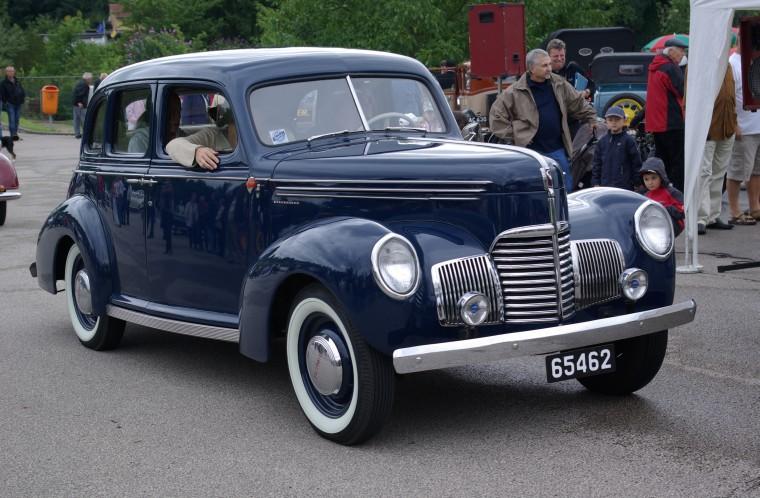 Tells: Note the (2) chrome strip on the hood and then the (1) additional strip on the hood skirt. On the 1940 cars there will only be two, the middle one will be removed. There is a thin full length chrome side molding that passes just above the door handles, this trim would become much larger and the door handles would become part of the side trim on the 1940 models. Note the oval headlights, they will become seal beam in 1940. The wider spacing of the grille teeth, both vertically and horizontally, will become much finer in 1940. The bumper will become larger and rounder next year. Tells: Note the (2) chrome strip on the hood and then the (1) additional strip on the hood skirt. On the 1940 cars there will only be two, the middle one will be removed. There is a thin full length chrome side molding that passes just above the door handles, this trim would become much larger and the door handles would become part of the side trim on the 1940 models. Note the oval headlights, they will become seal beam in 1940. The wider spacing of the grille teeth, both vertically and horizontally, will become much finer in 1940. The bumper will become larger and rounder next year.
1939
Studebaker Champion Series G
| Model |
No. Doors |
Passengers |
Original Price |
No. Produced |
Weight Lbs. |
| Coupe (Q1) |
2 |
3 |
$660.00 |
4,097 |
2,260 |
| Coupe DeLuxe (Q7) |
2 |
3 |
$720.00 |
1,949 |
2,275 |
| Club Sedan (F3) |
2 |
5 |
$700.00 |
9,578 |
2,330 |
| Club Sedan DeLuxe (F7) |
2 |
5 |
$760.00 |
2,649 |
2,345 |
| Cruising Sedan (W3) |
4 |
5 |
$740.00 |
6,775 |
2,360 |
Cruising Sedan DeLuxe (W7) |
4 |
5 |
$800.00 |
8,560 |
2,375 |
|
Chassis Only
|
297
|
????
|
| Total Production
|
33,905
|
| Production
South Bend – 30,305. Production Los Angles 3,599 - Total (33,904) — The production numbers (South Bend & Los Angeles) come from TW February 2015 (Fred Fox Article), individual model production numbers courtesy of Richard Quinn, same source. Chart Source: TW February 2015.
1939 Champion Specifications |
|
Engine |
164.3
CU IN, Bore 3”, Stroke 3 7/8”, HP 78 at 4,000 rpm |
|
Carburetor |
Carter
Model WO one-barrel |
|
Compression |
6.5
to 1 |
|
Wheelbase |
110
Inches |
|
Tires |
5.50
x 16 |
|
Fuel
Tank |
15
Gal. |
|
Restoration
Information |
|
Interior Fabric |
Custom Models, Bedford Cord
– Deluxe Models, Broadcloth. |
|
Deluxe Trim Additional
Interior Appointments |
Wood grain instrument panel
and garnish moldings, Phantom steering wheel, pile carpeting, a
strip of carpet at the door bottom that matched the floor
carpeting, broadcloth holstered door kick pads, door armrests
covered with leatherettte ,chrome appointments on dash and door
panels, and assist cords. |
|
Deluxe Trim Additional
Exterior Appointments |
Two windshield wipers, two
taillights, opening rear-quarter windows (four-door), front spring
covers, stainless rocker panel moldings, and rubber gravel
shields. |
|
Engine Colors |
Olive green with black air
cleaner canister and electrical components. Natural metal
carburetor and fuel pump. Some fans may have been painted black. |
|
SB Exterior Colors |
Velvet Black, Victorian
Blue, Praline Beige, Morocco Grey, Laurel Green. (Mid-Year)
Champion Maroon and Tulip Cream. |
|
LA Exterior Colors |
Velvet Black, Victorian
Blue, Praline Beige, Morocco Grey, Laurel Green. (Mid-Year)
Champion Maroon and Tulip Cream. LA Only Colors Grapetone Maroon,
Sun Valley Tan Metallic, Riviera Blue Metallic, Deauville Grey
Metallic, French Grey Metallic, Balsam Green, Clay Rust,
Delphinium Blue and Studebaker Cream |
|
SB Serial No. |
G-00,001 to G-30,500 |
|
LA Serial No. |
G-800,001 to 803,700 |
Deluxe
Style Equipment for Custom Champions |
|
Extra
windshield wiper – (AC-854) |
$5.00 |
|
Front
door arm rest (2) - (AC-858) |
$3.50 |
|
Robe
cord - (AC-859) |
$2.25 |
|
Extra
interior sun visor – (AC-848) |
$1.65 |
|
Assist
cords (2) - (AC-860) |
$1.75 |
|
Chrome
door sill panels (2) - (AC-856) |
$5.00 |
|
Extra
tail lamp – (AC-850) |
$3.50 |
|
Phantom
steering wheel - (AC-857) |
$10.50 |
Accessories & Options for 1939
Champions: For a detailed listing with photographs, see TW –
February 2015 page 29. Article by Fred Fox. Else click on this link to see a listing 1939 Accessories & Options | The three Charts above, are Sourced from information taken from TW February 2015.
The 1940 Champion:
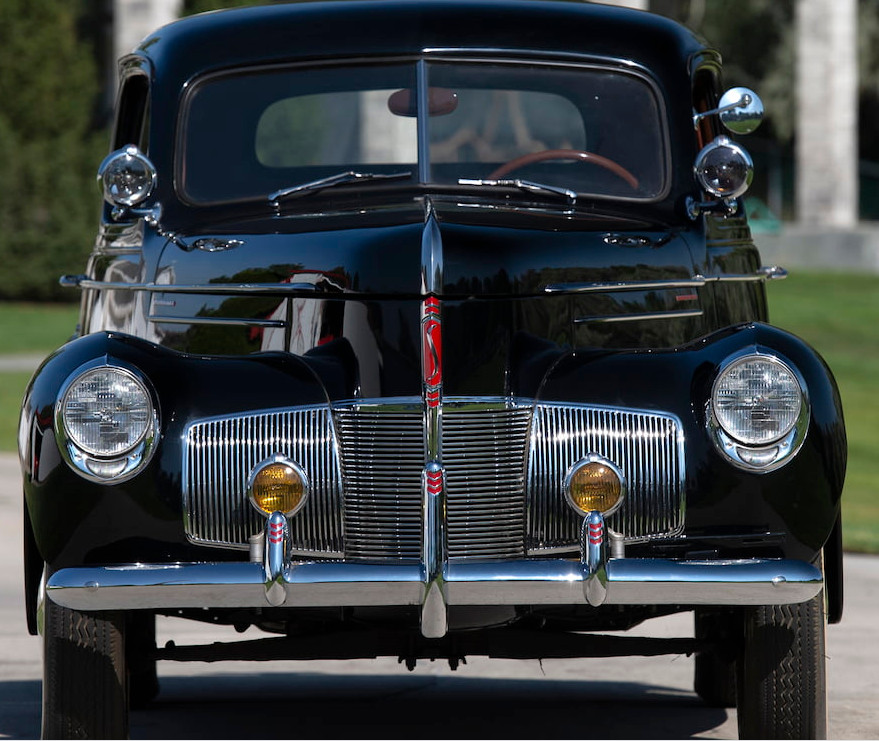 Tells: Changes for 1940 are mostly cosmetic, sealed-beam headlights appear (seen on
most American cars.) The four-piece grille is resumed, but with more
vertical and horizontal "teeth," door handles are
integrated with the belt moldings, and bumpers are larger and
rounder. One of the three trim stripes seen on the 1939 model hood is removed and the "Studebaker" badge is placed between the remaining two instead of below the lower strip. The hood release is moved inside the car under the instrument panel. The "S" badge is now fixed and in a lower position just above the grille, instead of being the hood release, as seen on 1939 models. Tells: Changes for 1940 are mostly cosmetic, sealed-beam headlights appear (seen on
most American cars.) The four-piece grille is resumed, but with more
vertical and horizontal "teeth," door handles are
integrated with the belt moldings, and bumpers are larger and
rounder. One of the three trim stripes seen on the 1939 model hood is removed and the "Studebaker" badge is placed between the remaining two instead of below the lower strip. The hood release is moved inside the car under the instrument panel. The "S" badge is now fixed and in a lower position just above the grille, instead of being the hood release, as seen on 1939 models.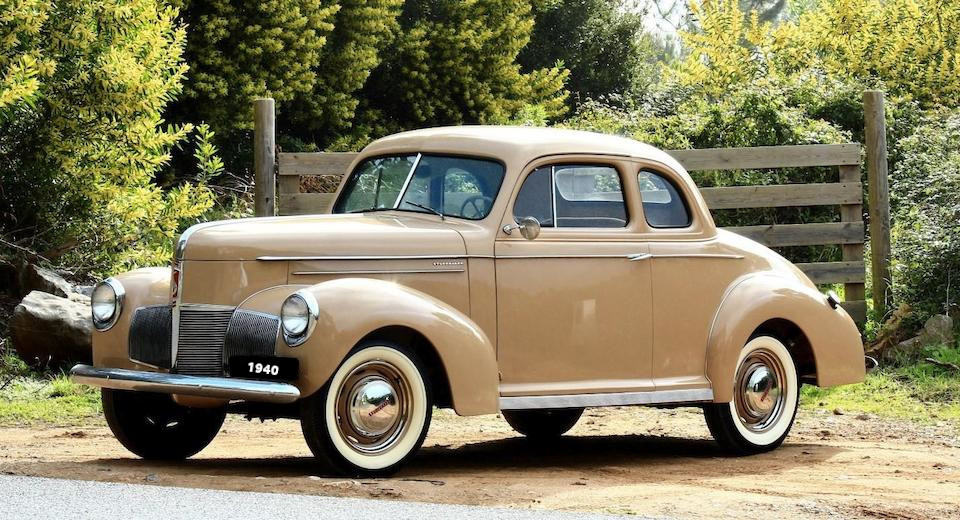
Spring covers are included on Custom models at no additional cost. The "opera" seats for late 1939 coupes, returned
for 1940 as a $35 "opera coupe" option, supplied by Edwards
Iron Works of South Bend.
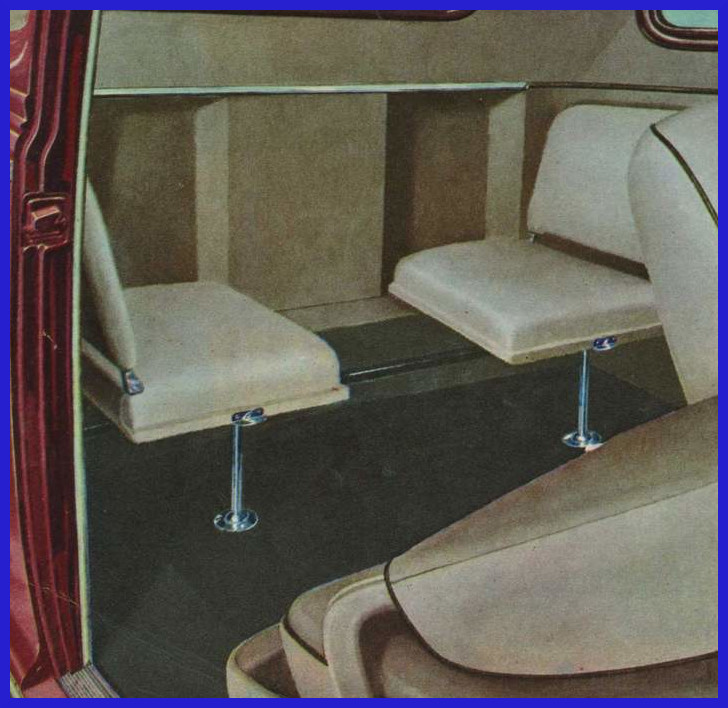
Additional Edwards Iron Works offerings:
Edwards also provided "Ambulance Coupe" and "Slumber Coupe" packages. However, the most unique 1940 Champion Edward's offering was the "Coupe Delivery," or
"Pick-up Coupe ," a cargo box measuring 31 inches wide and
18 inches high that slid into the trunk (the trunk lid was furnished
loose). A tailgate with stamped-in "Studebaker" lettering
was an option. The box cost $25 in black, $26.50 if painted another
color. (Left below Photo from HowStuffWorks.com)

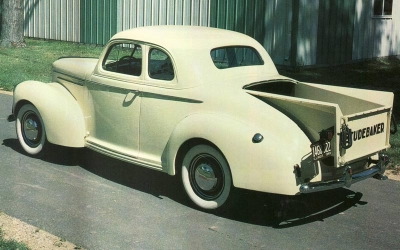
Edwards also did "Sedan Delivery" conversions (Photo Right). The Custom 2dr Sedan Delivery used the 1940 Champ Custom Club Sedan two-door, fitted with coupe floor pans and no rear
seats. Painted metal blanks were used instead of glass on the rear
side windows. Fiberboard was used on the rear inner sidewalls
from floor to ceiling. All for $36.50 added to the cost of the
regular two-door. Another $28 gets a partition with a sliding door
and a drawer.
The 1940 Studebaker Champion was initially delivered in three body styles (Coupe, Club Sedan, and Cruising Sedan). It came in two trim levels (Custom and Deluxe).
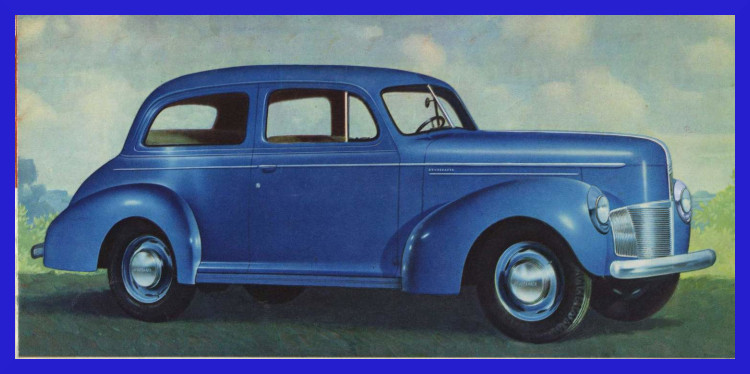 The Custom line was very "Plain Jane" with painted headlight rims, The Custom line was very "Plain Jane" with painted headlight rims, single tail light, one horn, one windshield wiper, fixed rear quarter window (Cruising Sedan), no arm rests, and single interior sun visor, and plain paint on the instrument panel and garnish molding.
 Deluxe line was then of course upscale, with two of everything the Custom line had one of. Added items were chrome headlight rims, ventilating rear quarter window (Cruising Sedan), Robe Cord (Cruising Sedan), upgraded fabric (Broadcloth), interior door panel chrome strips with carpet kick pads on the lower part of the doors, wood grained instrument panel and garnish moldings, front arm rests, Phantom steering wheel & horn ring, rear seat ash tray, Tenite gear shift lever knob, and Stainless steel rocker panel molding. Deluxe line was then of course upscale, with two of everything the Custom line had one of. Added items were chrome headlight rims, ventilating rear quarter window (Cruising Sedan), Robe Cord (Cruising Sedan), upgraded fabric (Broadcloth), interior door panel chrome strips with carpet kick pads on the lower part of the doors, wood grained instrument panel and garnish moldings, front arm rests, Phantom steering wheel & horn ring, rear seat ash tray, Tenite gear shift lever knob, and Stainless steel rocker panel molding.
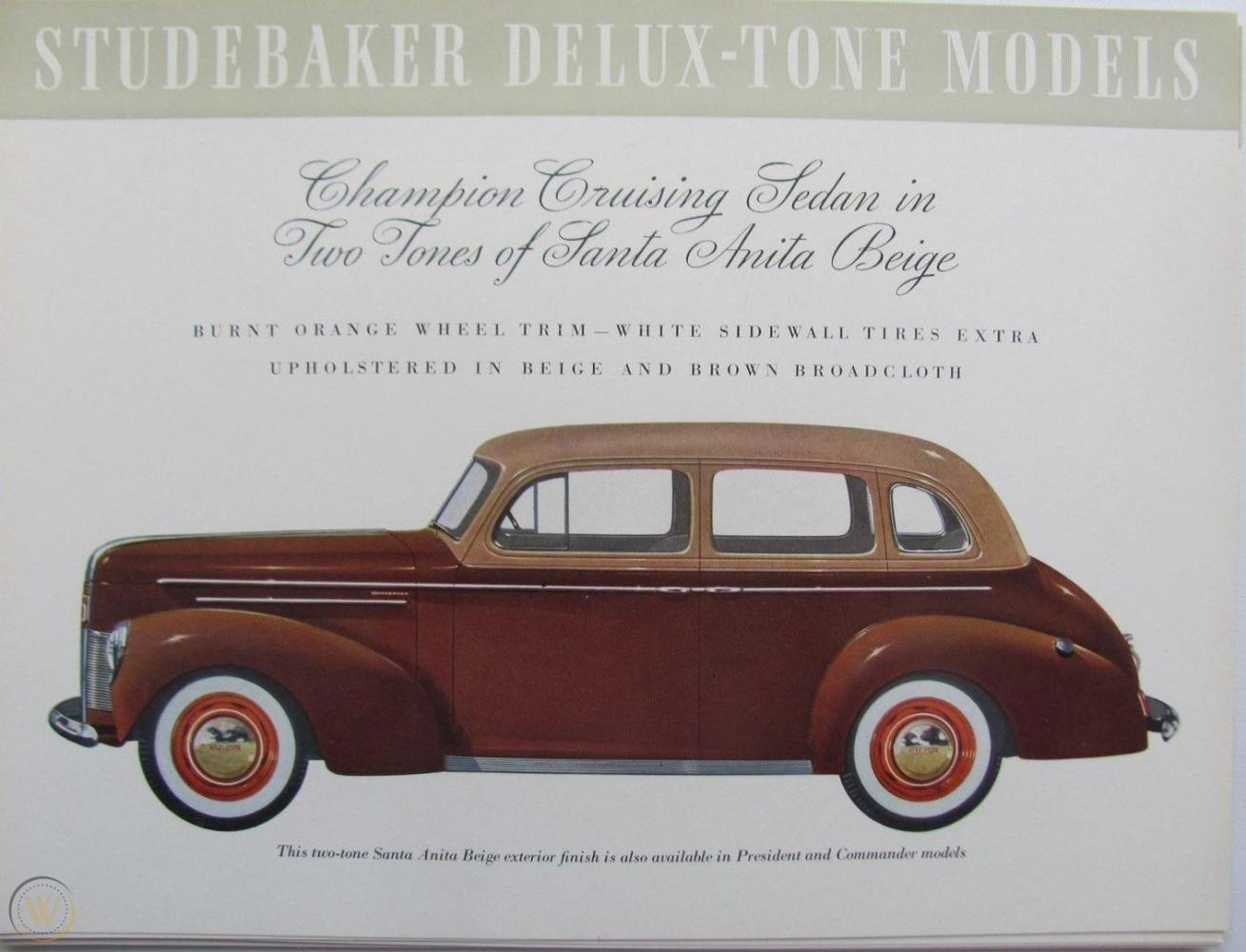 In the spring of 1940 Studebaker added two additional trim levels, "Custom Deluxe", between "Custom" and "Deluxe" existing trims. They also added "Delux-tone" as the top trim level. Custom Deluxe only came in solid external colors, but featured two-tone interiors, two-tone instrument panel, and four bumper guards. Delux-tone had all the Deluxe features, but came in a choice of five different color combinations with color matching two-tone interiors. In the spring of 1940 Studebaker added two additional trim levels, "Custom Deluxe", between "Custom" and "Deluxe" existing trims. They also added "Delux-tone" as the top trim level. Custom Deluxe only came in solid external colors, but featured two-tone interiors, two-tone instrument panel, and four bumper guards. Delux-tone had all the Deluxe features, but came in a choice of five different color combinations with color matching two-tone interiors.
In the 1940 Gilmore Yosemite Economy Run, Champion produced the best mileage results at
29.19 mpg. In recognition of its popularity and economy, the
Champion is selected to pace the 1940 Indianapolis 500, a DeLuxe
two-door, earned the distinction of being the first closed car picked
to pace the 500. The Champion nearly doubled its 1939 volume, ending
the 1940 model year (June) at 66,624 cars (including 7,000 +
assembled at the LA plant). That would be over 100,000 sales in less
then two years.
Note: Ref. Material from “HowStuffWorks” and TW April 1996 was used to create the above information. A lot of the original information is shortened and summered. Any
errors in translation are the solely the responsibility of the
authors.
Engine color is olive green, with black air cleaner and electrical components (generator, starter, etc). Natural metal parts are carburetor and fuel pump. Fans would normally be engine color, but some were black.
1940 Champion Exterior Paint Colors |
|
Custom, Custom DeLuxe and DeLuxe Models South Bend production |
|
Color |
Wheel Color |
|
Velvet Black |
Velvet Black |
|
Tulip Cream |
Tulip Cream |
|
Laurel Green |
Laurel Green |
| Champion Maroon
|
Champion Maroon |
|
Belmont Tan |
Belmont Tan |
|
Pilgrim Gray |
Pilgrim Gray |
|
Belvedere Blue |
Belvedere Blue |
|
Ruby Red |
Ruby Red |
| Custom, Custom DeLuxe and DeLuxe Models Los Angeles (Vernon) production |
|
Color |
|
Riviera Blue Metallic |
California Grapetone Maroon |
|
Clipper Gray Light Metallic |
Colleen Green Light Metallic |
|
Birchleaf Light Metallic |
Santa Anita Beige Light Metallic |
|
Clipper Gray Dark Metallic |
Colleen Green Dark Metallic |
|
Birchleaf Dark Metallic |
Studebaker Cream |
Some of the light or dark colors (Los Angeles) may not have been available on Champions as they may have just been accent colors for Commanders & Presidents. Wheel colors were likely body color, but there may have been exceptions.
Most models came with two wheel stripes, thick on the inner, and thin on the outer. While the colors are unknown, we do know that both stripes were the same color and that they were in contrast to the wheel color. |
1940 Champion DeLux-tone Exterior Colors |
|
Upper Body Color |
Lower Body Color |
Wheel Color |
|
Riviera Blue-Gray |
Riviera Blue |
Maroon |
|
Clipper Light Grey |
Clipper Dark Grey |
Burnt Orange |
|
Paddock Green Light |
Paddock Green Dark |
Maroon |
|
Birchleaf Light |
|
Burnt Orange |
|
Santa Anita Beige Light |
Santa Anita Beige Dark |
Burnt Orange |
|
Most, if not all, of the above Delux-tone body colors were metallic's. |
1940 Champion Upholstery Fabrics |
|
Custom Models |
Custom DeLuxe Models |
DeLuxe Models |
DeLux-Tone Models |
|
Standard: Wool fabrics |
Standard: Two-tone Wool fabric |
Standard: Broadcloth |
1 Standard: Broadcloth in the following colors: |
|
Optional: Mohair ($5.00 extra) |
Optional: Mohair ($5.00 extra) |
Optional: Mohair ($5.00 extra) |
Exterior Color
|
Upholstery Colors |
|
Optional: Light tan leather with leatherette trim ($14.00 on coupes; $24 on sedans) |
Optional: Light tan leather with leatherette trim ($14.00 on coupes; $24 on sedans |
Optional: Light tan leather with leatherette trim ($14.00 on coupes; $24 on sedans |
Two-tone Riviera Blue |
Blue & Grey Broadcloth |
|
Optional: Blue-Gray, black, medium maroon, medium green or light red leather ($25 on coupes; $34 on sedans) |
Optional: Blue-Gray, black, medium maroon, medium green or light red leather ($25 on coupes; $34 on sedans) |
Optional: Blue-Gray, black, medium maroon, medium green or light red leather ($25 on coupes; $34 on sedans) |
Two-tone Clipper Gray |
Blue & Grey Broadcloth |
1 Part leather on green cars
Custom Interior
Club
Sedan
Deluxe
Interior
Cruising
Sedan |
|
Light Green Broadcloth & Dark Green Leather |
|
Two-tone Birchleaf |
Light Green Broadcloth & Dark Green leather |
Two-tone
Santa Anita Beige |
Brown & Beige broadcloth |
1940 Champion Specifications |
|
Engine |
164.3
CU IN, Bore 3”, Stroke 3 7/8”, HP 78 at 4,000 rpm |
|
Carburetor |
Carter
Model WO one-barrel |
|
Compression |
6.5
to 1 |
|
Wheelbase |
110
Inches |
|
Tires |
5.50
x 16 |
|
Fuel
Tank |
15
Gal. |
1940
Studebaker Champion Series 2G, 110 In. wheelbase
|
Model |
No. Doors 2 |
Passengers 2 |
TW Price |
CCD Price 2 |
No. Produced |
|
Custom Coupe Q1 |
2 |
3 |
$660.00 |
$660.00 |
8,127 |
|
Custom Deluxe Coupe Q2 |
2 |
3 |
|
|
|
|
Custom Coupe w/Opera Seats Q3 |
2 |
3/5 1 |
$695.00 |
|
2,559 |
|
Custom Deluxe Coupe w/Opera Seats Q4 |
2 |
3/5 1 |
$725.00 |
|
220 |
|
Deluxe Coupe Q7 |
2 |
3 |
$705.00 |
|
1,642 |
|
Delux-tone Coupe Q8 |
2 |
3 |
$720.00 |
$720.00 |
380 |
|
Deluxe Coupe w/Opera Seats Q9 |
2 |
3/5 1 |
$740.00 |
$740.00 |
1,069 |
|
Delux-tone Coupe w/Opera Seats Q10 |
|
3/5 1 |
$755.00 |
$755.00 |
118 |
|
Custom Cruising Sedan W3 |
4 |
5 |
$740.00 |
|
11,470 |
|
Custom Deluxe Cruising Sedan W5 |
4 |
5 |
$770.00 |
Not Listed |
1,357 |
|
Deluxe Cruising Sedan W7 |
4 |
5 |
$785.00 |
$785.00 |
7,516 |
|
DeLux-tone Cruising Sedan W9 |
4 |
5 |
$800.00 |
$800.00 |
1,594 |
|
Custom Club Sedan F3 |
2 |
5 |
$700.00 |
|
22,574 |
|
Custom Deluxe Club Sedan F5 |
2 |
5 |
$730.00 |
Not Listed |
2,561 |
|
Deluxe Club Sedan F7 |
2 |
5 |
$745.00 |
$745.00 |
4,124 |
|
Delux-tone Club Sedan F9 |
2 |
5 |
$760.00 |
$760.00 |
1,280 |
|
Chassis Z1 |
|
|
|
|
unknown |
|
Total |
67,256 |
Serial
Number SB G-30,501 – 90,069 Serial Number LA G-803,701 – 811,191 Engine
Number 34,101 – 101,169
1 The
Opera Coupe had two fold-up jump seats in the rear (no seat).
2 Classic Car Database
Source: CCD & TW April 1996
Tells:
The
1941 Champion is an extensive face lift. It is 1 ¾ in longer, ½
inch lower, and 2 ¾ inch wider. A new wider and lower two piece
vertical bar grill replaces the four piece affair found on the 1939 &
1940 models. Clearly
the most prominent feature is the arrangement of new twin stainless
trim on the side, referred as the “color belt.” It starts out
wide at the very front of the hood and narrows to a point at the
rear of the body, making the identification of 1941 Champions very
easy. This side treatment is seen on all Studebaker's for 1941
(except the mid-year Commander & President Skyways) and would be
unique for 1941 only. The glass area is increased by 205 ½ square
inches (4dr sedans). Curved tempered rear window glass is used. Three cubic feet is added to the trunk and hip room is significantly
greater in both the front and rear seat area. The rear seat is
moved forward 2 ¼ inches, making for a better ride for the rear
passengers. New
larger, longer, and narrower tail lights, with much thicker bezels,
are fitted into the body instead of the rear fenders (Commanders and
Presidents used the same tail lights). The front and rear bumpers
look larger and more substantial. This would be the first year for
those famous side vent doors in the front fenders, which would be
seen on all Studebaker cars through 1957 and on Hawks through 1964. The all new instrument panel was designed and used across the entire
Studebaker line (shared with Commander & President). A gravel
deflector is added between the body and rear bumper.
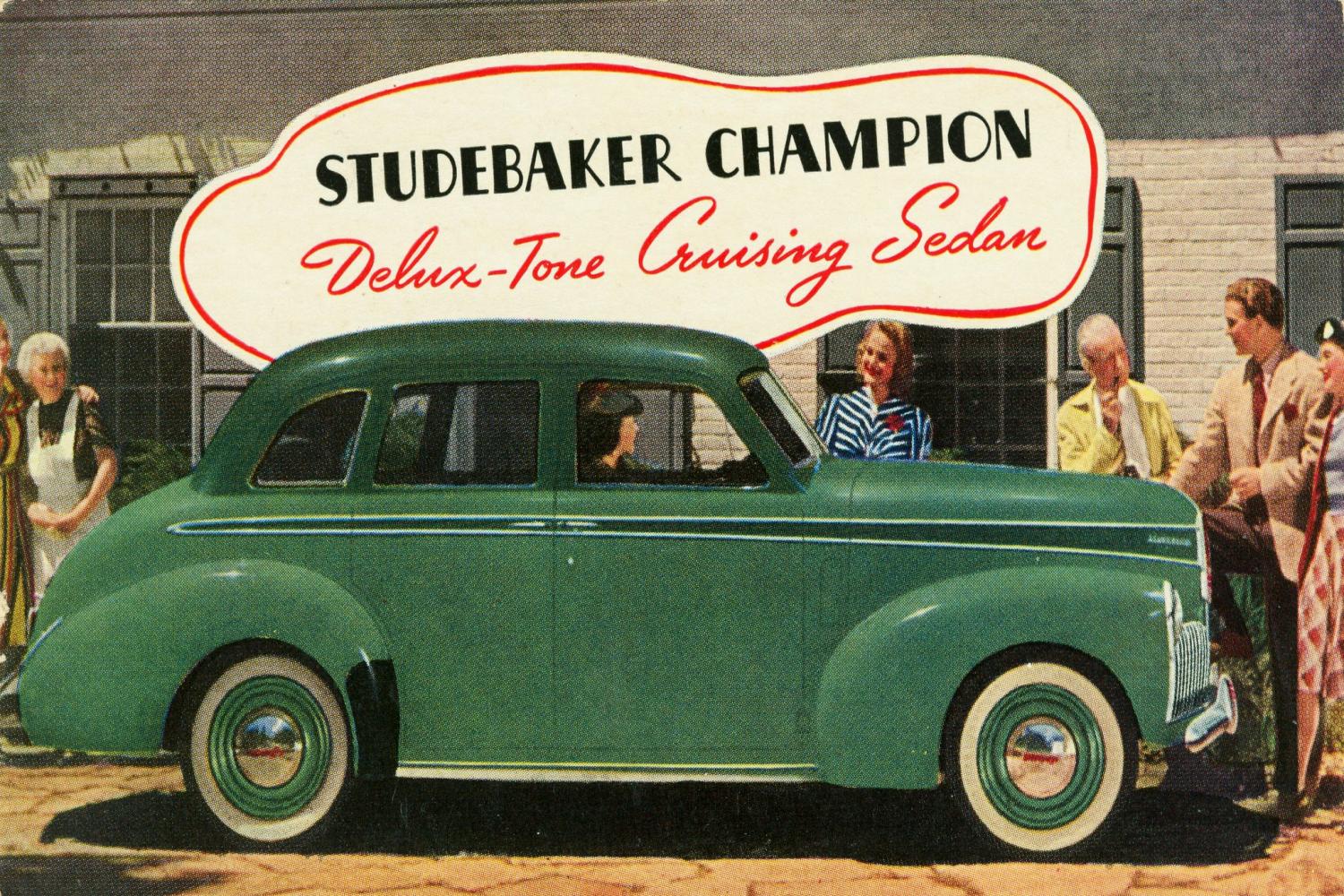 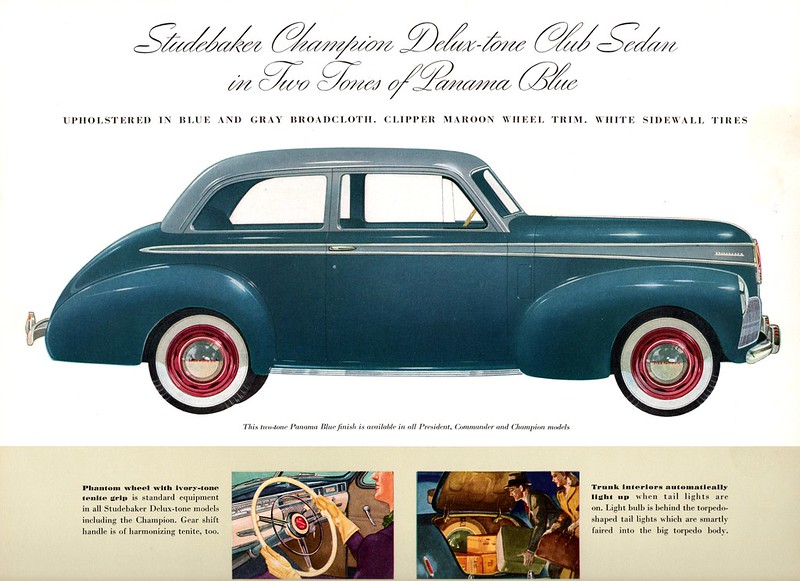 The
same three models seen since 1939 are released (Coupe, Club Sedan,
and Crusing Sedan), in three trim levels (Custom, Custom Deluxe,and
Delux-tone). Most of the special coupe conversions from Edwards are
continued in 1941, Opera Coupe, Slumber Coupe, Ambulance-Coupe, and
Coupe-Delivery. New offering would be a Coupe-Sedan which had a
small bench seat in the back, discontinued would be the Club Sedan
based “Sedan-Delivery”.
In
January Studebaker would release a new five passenger coupe
configuration called the “Double-Dater' that would feature a
permanent rear seat that was more comfortable then the Opera Coupe
jump seat model or the bench seat Coupe-Sedan Edwards conversion. This would go on to be one of Studebaker's more popular models and
would also be seen in 1942 and 1946.
Engine
HP is increased to 80 as the engine bore is now 4 inches (169.6 cid),
improved manifold and carburetor keep the economy about the same. A
new automatic choke is standard equipment. The front suspension gets
an additional transverse spring leaf and new safety links. Gravel
deflectors, improved engine pans and better weather stripping are
provided on all Champions. The Champion becomes the highest volume
Studebaker ever produced in a single model-year.
1941 Champion Specifications |
|
Engine |
169.6 CU IN, Bore 3”, Stroke 4”, HP 80 at 4,000 rpm, torque 134 ft.-lbs. |
|
Carburetor |
Carter
Model WA1-496S one-barrel |
|
Compression |
6.5
to 1 |
|
Wheelbase |
110
Inches |
| Electrical |
6-volt, positive ground, Willard battery, Auto-lite components |
|
Tires |
5.50
x 16 4ply blackwalls (Whitewalls were standard on Delux-tone models.) |
|
Capacities |
Fuel Tank 15
Gal. - Crankcase 5 quarts - Cooling system 10 quarts |
|
Engine Colors |
Engine Olive green, black air cleaner, oil filter caps, and electrical components. Fans could be either black or olive green. |
1941 Champion Upholstery Fabrics |
|
Custom Models |
Custom DeLuxe Models
(color keyed) |
Early DeLux-Tone Models (color Keyed) |
|
Standard: One-tone Beige medium Bedford Cord |
Standard: (early) Green, Blue, or Brown Canda cloth |
Seats |
Bolsters |
|
Optional: Brown Canda cloth. |
Standard: (late) lighter versions of the above three Canda cloth. |
Blue broadcloth
|
Grey broadcloth |
|
Optional (Late): Grey Canda cloth. |
Optional: Dark Beige or Blue Bedford Cord |
Brown broadcloth |
Beige broadcloth |
|
Late DeLux-tone Models (color keyed) Optional:
Bolsters (extra cost) leather, available in Blue, Brown, or Dark Green |
|
|
Late DeLux-Tone Models (color Keyed) |
|
|
|
|
|
Blue broadcloth |
|
|
Brown broadcloth |
|
|
Dark green broadcloth |
1941 Champion Custom & Custom DeLuxe Exterior Colors |
| Fall Colors |
|
Body Color |
Belt Color (at Intro.) |
Belt Color (later) |
|
Velvet Black |
Velvet Black |
Velvet Black |
|
Tulip Cream |
Tulip Cream |
Tulip Cream |
|
Winetone Maroon |
Winetone Maroon |
Ruby Red |
|
Ruby Red |
|
Winetone Maroon |
|
Fern Leaf Green Dark |
Fern Leaf Green Dark |
Fern Leaf Green Light |
|
Dawn Grey Dark |
Dawn Grey Dark |
Dawn Grey Light |
|
Palm Green Dark |
Palm Green Dark |
Palm Green Light |
|
Malibu Beige Dark |
Malibu Beige Dark |
Malibu Beige Light |
|
Panama Blue Dark |
Panama Blue Dark |
Panama Blue Light |
|
Beverly Blue |
Not Available |
Dawn Grey Dark |
| Beverly Blue |
Not Available |
Dawn Grey Light |
|
Spring Colors |
|
Body |
Belt |
|
Velvet Black |
Velvet Black |
|
Tulip Cream |
Tulip Cream |
|
Winetone Maroon |
Ruby Red |
|
Ruby Red |
Winetone Red |
|
Mountain Green Dark |
Mountain Green Light |
|
Mountain Green Light |
Mountain Green Dark |
|
Alpine Blue |
Cloud Grey |
|
Cloud Grey |
Alpine Blue |
|
Sunstar Beige Dark |
Sunstar Beige Light |
|
Sunstar Beige Light |
Sunstar Beige Dark |
|
Dawn Grey Dark |
Dawn Grey Light |
| Dawn Grey Light |
Dawn Grey Dark |
|
Note 1) The contrasting belt color was a $5 delete option.
Additional solid colors were available from Vernon (Los Angles) - Fern Leaf Green Light, Malibu Beige Light, Dawn Grey Light, Panama Blue Light, and Palm Green Light. (Ref. Rex Miltenberger) |
1941 Champion DeLux-tone Exterior Colors |
| Fall Colors |
|
Body Color |
Top Body & Belt Color
|
|
Fern Leaf Green Dark |
Fern Leaf Green Light |
|
Palm Leaf Green Dark |
Palm Leaf Green Light |
|
Dawn Grey Dark |
Dawn Grey Light |
|
Malibu Beige Dark |
|
|
Panama Blue Dark |
Panama Blue Light |
|
*Beverly Blue |
*Dawn Grey Light |
*Not Listed at
Introduction Time. |
| Spring Colors |
|
Body |
Top |
Belt |
|
Velvet Black |
|
|
|
Tulip Cream |
|
|
|
Winetone Maroon |
|
Ruby Red** |
|
|
|
|
|
|
Sunstar Beige Dark
|
| Cloud Grey |
Alpine Blue |
Alpine Blue |
|
Mountain Green Light |
Mountain Green Dark |
Mountain Green Dark |
| Dawn Grey Light |
Dawn Grey Dark |
Dawn Grey Dark |
|
**If specified, these belts could be ordered the same color as the body. Wheel and stripe colors for the various color combinations are listed in the "Studebaker Passenger Car and Truck Color Combination Paint Charts". 1941 Champions had two wheel stripes, the inner one was 1/4 inch and the outer one was 1/16 inch. The inner edge of the 1/4 in stripe was 1/2 inch from the edge of the hubcap. There was 1/8 inch between the two stripes. Both stripes on a given car were the same color and were in contrast to the wheel color. The welt was sometimes black and sometimes body color (Rex Miltenberger). |
Special Paint Information:(Rex Miltenberger)
A) The trunk door inside including hinges #7440 Brookwood Beige Enamel.
B) Rear compartment (trunk) spray the entire inside with Sherwin Williams #7371 Brookwood Beige Adhesive, after which spray with Claremont Company's #7370 Brookwood Beige Rayon Flock. On 3/3/41 flock changed to Wedgewood Tan #S1957.
|
1941
Studebaker Champion Series 3G, 110 in. wheelbase |
|
4Model |
3No.
Doors |
3No.
Pass |
3CCD
Price |
4TW
Price 10/40 2/41 |
|
Custom
Coupe Q1 |
2 |
3 |
$690 |
$690
/ $695 |
|
Custom Opera Coupe Q3 |
2 |
3/51 |
$725 |
$725
/ $735 |
|
Custom
Double Dater Coupe Q3S |
2 |
5 |
$725 |
$-----
/ $735 |
|
Custom
Deluxe Coupe Q2 |
2 |
3 |
$720 |
$720
/ $730 |
|
Custom
DeLuxe Opera Coupe Q4 |
2 |
3/51 |
$755 |
$755
/ $765 |
|
Custom
DeLuxe Double Dater Coupe Q4S |
2 |
5 |
$755 |
$-----
/ $765 |
|
Delux-tone
Coupe Q8 |
2 |
3 |
$755 |
$755
/ $765 |
|
Delux-tone
Opera Coupe Q10 |
2 |
3/51 |
$790 |
$790/
$800 |
|
Delux-tone
Double Dater Coupe Q10S |
2 |
5 |
$790 |
$----
/ $800 |
|
Custom
Club Sedan F3 |
2 |
5 |
$730 |
$730
/ $740 |
|
Custom
Cruising Sedan W3 |
4 |
6 |
$770 |
$770
/ $780 |
|
Custom
DeLuxe Club Sedan F5 |
2 |
5 |
$760 |
$760
/ $770 |
|
Custom
Deluxe Cruising Sedan W5 |
4 |
6 |
$800 |
$800
/ $810 |
|
Delux-tone
Club Sedan F9 |
2 |
5 |
$795 |
$795
/ $805 |
|
Delux-tone
Cruising Sedan W9 |
4 |
6 |
$835 |
$835
/ $845 |
|
2Total Production |
85,002 |
Serial
Number SB G-90,101 – 165,400 Serial Number LA G-811,201 – 820,902 Engine
Number 101,201 – 186,259
1The Opera Coupe had two fold-up jump seats in the rear (no seat).
2TW reported 84,910 Champions were produced, however the serial
numbers indicate 85,002. The 92 difference is likely chassis sold
without bodies.
Source:3Classic Car Database (CCD) & 4
TW April 1998
With the
1941 Studebaker's being a completely new body design and with the war
looming it's somewhat 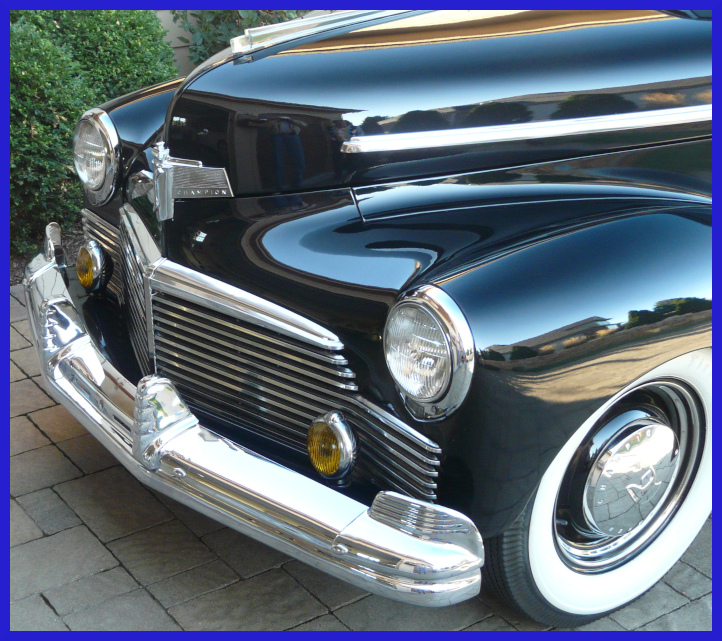 puzzling that significant changes are made to
the 1942 Champion. New frontal sheet metal and a new grille,
extended under (wider) and above (alongside) the headlights, with
horizontal bars, giving the 42's a fresh new look. Gone is the twin
belt line moldings, in favor of a single somewhat wider molding that
starts near the front of the hood and extends to just aft puzzling that significant changes are made to
the 1942 Champion. New frontal sheet metal and a new grille,
extended under (wider) and above (alongside) the headlights, with
horizontal bars, giving the 42's a fresh new look. Gone is the twin
belt line moldings, in favor of a single somewhat wider molding that
starts near the front of the hood and extends to just aft 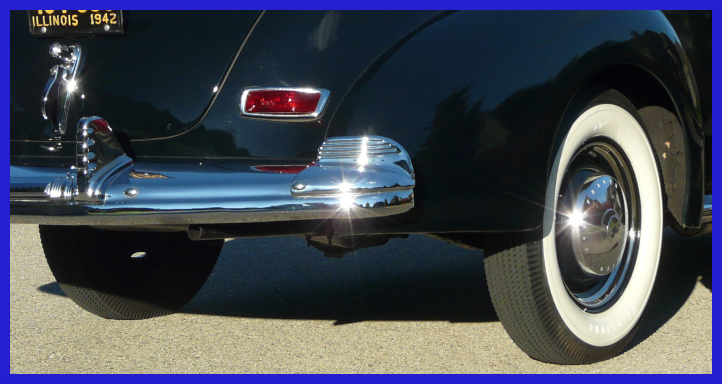 of the rear
window. The taillights are still mounted in the body, but are now
horizontal with much smaller bezels. The bumper size is again
enhanced and the bumper guards are redesigned as well. Custom Deluxe trim
is gone and the Opera Coupes are gone as well. There were no substantial mechanical upgrades. The model-year
is short with normal production ending in December of 1941 and
black-out car production ending late January 1941. of the rear
window. The taillights are still mounted in the body, but are now
horizontal with much smaller bezels. The bumper size is again
enhanced and the bumper guards are redesigned as well. Custom Deluxe trim
is gone and the Opera Coupes are gone as well. There were no substantial mechanical upgrades. The model-year
is short with normal production ending in December of 1941 and
black-out car production ending late January 1941.
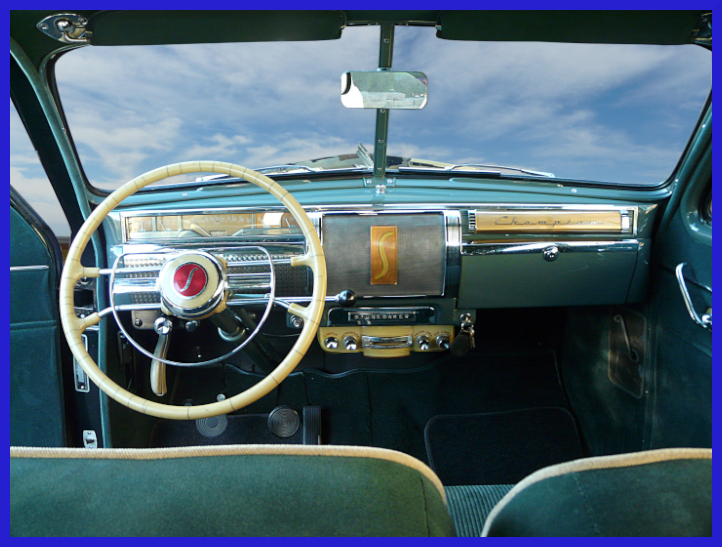 We were unable to find any information on paint colors or interior fabric or any other restoration information, but do have an interior shot of a Custom Club Sedan once owned by a local SDC Club member. The owner did not know if the interior fabric and colors were authentic or not. We were unable to find any information on paint colors or interior fabric or any other restoration information, but do have an interior shot of a Custom Club Sedan once owned by a local SDC Club member. The owner did not know if the interior fabric and colors were authentic or not.
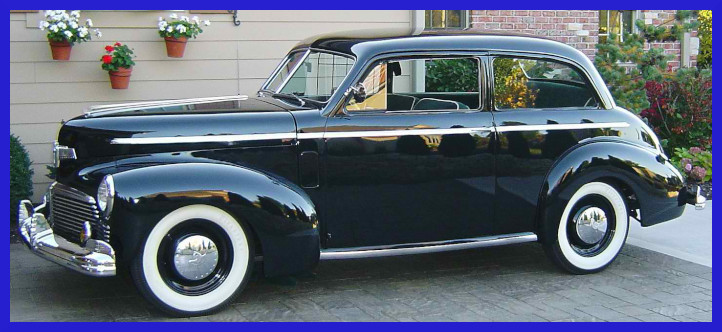 The Champion line was the same models as 1941, Coupe, Double Dater Coupe, Club Sedan, and Cruising Sedan. However there are now only two trim levels, Custom and Deluxstyle replacing Delux-tone. Custom Club Sedan shown in the right photo. The Champion line was the same models as 1941, Coupe, Double Dater Coupe, Club Sedan, and Cruising Sedan. However there are now only two trim levels, Custom and Deluxstyle replacing Delux-tone. Custom Club Sedan shown in the right photo.
Right photo Deluxstyle Club Sedan
Left photo Deluxstyle Cruising Sedan
There is little information written about 1942 Studebaker's and even less information is available about the Champion. Nothing showed in the TW index, other then an article on the Model 90 (the blackout car manufactured during January of 1942).
|
1942
Studebaker Champion Series 4G, 110 in. wheelbase |
|
Model |
No.
Doors |
Passengers |
CCD
Price |
No.
Produced |
|
|
2 |
3 |
$810 |
29,678* |
|
Deluxstyle Coupe Q8 |
2 |
3 |
$845 |
29,678* |
|
Custom Double Dater
Coupe Q3S |
2 |
5 |
$835 |
29,678* |
|
Deluxstyle Double Dater
Coupe Q10S |
2 |
5 |
$870 |
29,678* |
|
Custom Club Sedan F3 |
2 |
5 |
$840 |
29,678* |
|
Custom Cruising Sedan W3 |
4 |
6 |
$870 |
29,678* |
|
Deluxstyle Club Sedan F9 |
2 |
5 |
$875 |
29,678* |
|
Deluxstyle Cruising Sedan W9 |
4 |
6 |
$905 |
29,678* |
Starting
Serial Number SB G-165,501 Starting Serial Number LA G-821,001
Starting
Engine Number 186,301
*
Production for all Champion models.
Source:
Classic Car Database. Crestline Studebaker Cars listed prices
exactly $25 under the prices listed here.
|